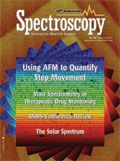53rd Annual ASMS Wrap Up
A review of the five-day conference dedicated to promoting mass spectrometry and its allied topics held earlier this month in San Antonio, TX.
The 53rd Annual American Society for Mass Spectrometry (ASMS) Conference on Mass Spectrometry and Allied Topics was held June 5–9 at the Henry B. Gonzalez Convention Center in San Antonio, TX (pictured). More than 6000 scientists attended, and some 2700 papers were presented as posters and talks.

Each conference day opened with a plenary lecture followed by six parallel oral sessions and two periods of formal poster presentations. Plenary lecturers included Firouz Naderi of Jet Propulsion Laboratory (Pasadena, CA) speaking on the Mars landings in his lecture entitled, "Six Intense Minutes, a Hole in One, and a Salty Sea — the Landing of NASA's Mars Exploration Rovers," and Don Catlin of the UCLA Olympics Laboratory (Los Angeles, CA) discussing drug testing of athletes in his presentation, "Drugs, Sports, and Mass Spectrometry."
Additional plenary lectures included two award recipients, James A. McCloskey of the University of Utah (Salt Lake City, UT), who received The Award for a Distinguished Contribution to Mass Spectrometry, and Gary Van Berkel of Oak Ridge National Laboratory (Oak Ridge, TN), who was awarded with the Biemann Medal.
Continuing the trend of recent ASMS conferences, more than half of the presentations represented the areas of proteomics, drug metabolism, and other biomedical applications. While the bioanalytical applications of mass spectrometry were a significant part of the meeting, flavor and fragrance, environmental, and polymer interests groups also were well represented. The mechanisms for soft ionization techniques and fundamental ion molecule reactions were discussed, as were instrumental and ionization developments that showed improvements in resolution, sensitivity, and mass accuracy.
The application of mass spectrometry to the field of proteomics included identification of novel proteins, biomarkers, protein conformation, and protein–protein interactions, as well as the development of new instrumentation, new software, and new strategies for isotope labeling of proteins. Portable instrumentation developments and new methods for detecting of biotoxins, neurotoxins, and pathogens relative to Homeland Security were presented. Environmental issues, such as the detection of pharmaceuticals, toxins, microorganisms, and flame retardants, also were reported.
With such an intensive program, the conference initiated web casting as a way to provide participants the opportunity to view the presentations they missed. The presentations were made available for viewing on-line through the week following the conference.
In addition to exhibit booths, exhibitors also hosted hospitality suites at the Marriott Hotel Rivercenter on Monday, Tuesday, and Wednesday evenings. This provided opportunities for conference registrants to relax at the end of the day and view more extensive displays of company products and services.
The weekend preceding the conference featured 11 short courses attended by 900 participants, tutorial lectures, and customer meetings sponsored by various exhibitors. Some of the short courses included: FT MS: Principles and Application; LC–MS: The Techniques of Electrospray and APCI; MALDI-TOF MS: Fundamentals and Applications; Drug Discovery Using Mass Spectrometry: From Target Identification to IND Enabling Studies; and Quadrupole Ion Trap Mass Spectrometry and Tandem Mass Spectrometry.
The conference kicked off with an opening reception in the exhibit hall where some 170 exhibitors were represented. However, unlike most large conferences, a sea of 660 scientific posters occupied most of the exhibit hall space. These presentations changed daily for a total of approximately 2400 posters.
Next year, the 54th Annual ASMS Conference will be held May 28–June 1 in Seattle, WA. For more information, contact ASMS at:
2019 Galisteo St., Building I-1
Santa Fe, NM 87505
Tel: (505) 989-4517
Fax: (505) 989-1073
E-mail: office@asms.org
High-Speed Laser MS for Precise, Prep-Free Environmental Particle Tracking
April 21st 2025Scientists at Oak Ridge National Laboratory have demonstrated that a fast, laser-based mass spectrometry method—LA-ICP-TOF-MS—can accurately detect and identify airborne environmental particles, including toxic metal particles like ruthenium, without the need for complex sample preparation. The work offers a breakthrough in rapid, high-resolution analysis of environmental pollutants.
The Fundamental Role of Advanced Hyphenated Techniques in Lithium-Ion Battery Research
December 4th 2024Spectroscopy spoke with Uwe Karst, a full professor at the University of Münster in the Institute of Inorganic and Analytical Chemistry, to discuss his research on hyphenated analytical techniques in battery research.
Mass Spectrometry for Forensic Analysis: An Interview with Glen Jackson
November 27th 2024As part of “The Future of Forensic Analysis” content series, Spectroscopy sat down with Glen P. Jackson of West Virginia University to talk about the historical development of mass spectrometry in forensic analysis.
Detecting Cancer Biomarkers in Canines: An Interview with Landulfo Silveira Jr.
November 5th 2024Spectroscopy sat down with Landulfo Silveira Jr. of Universidade Anhembi Morumbi-UAM and Center for Innovation, Technology and Education-CITÉ (São Paulo, Brazil) to talk about his team’s latest research using Raman spectroscopy to detect biomarkers of cancer in canine sera.
